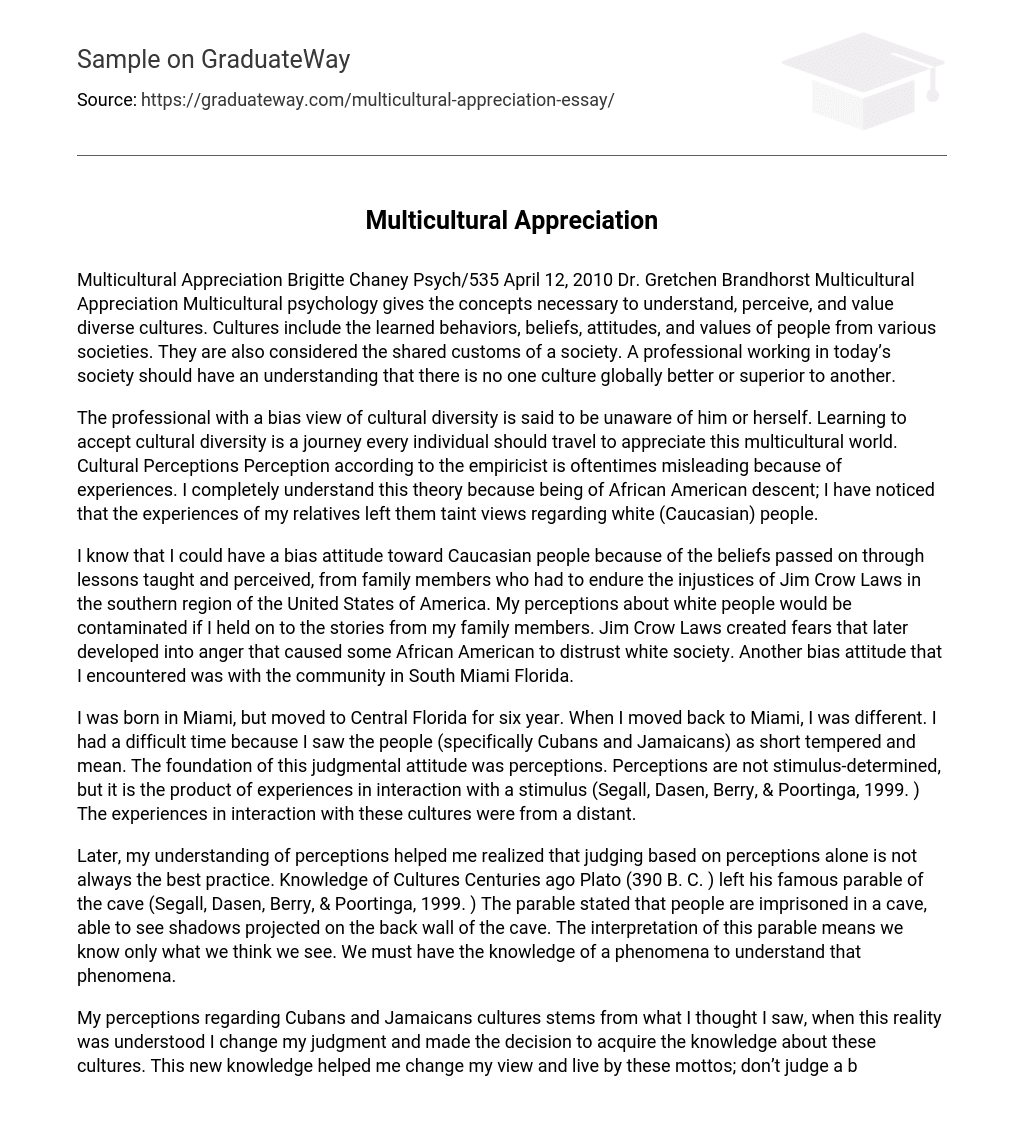Appreciation Multicultural psychology gives the concepts necessary to understand, perceive, and value diverse cultures. Cultures include the learned behaviors, beliefs, attitudes, and values of people from various societies. They are also considered the shared customs of a society. A professional working in today’s society should have an understanding that there is no one culture globally better or superior to another.
The professional with a bias view of cultural diversity is said to be unaware of him or herself. Learning to accept cultural diversity is a journey every individual should travel to appreciate this multicultural world. Cultural Perceptions Perception according to the empiricist is oftentimes misleading because of experiences. I completely understand this theory because being of African American descent; I have noticed that the experiences of my relatives left them taint views regarding white (Caucasian) people.
I know that I could have a bias attitude toward Caucasian people because of the beliefs passed on through lessons taught and perceived, from family members who had to endure the injustices of Jim Crow Laws in the southern region of the United States of America. My perceptions about white people would be contaminated if I held on to the stories from my family members. Jim Crow Laws created fears that later developed into anger that caused some African American to distrust white society. Another bias attitude that I encountered was with the community in South Miami Florida.
I was born in Miami, but moved to Central Florida for six year. When I moved back to Miami, I was different. I had a difficult time because I saw the people (specifically Cubans and Jamaicans) as short tempered and mean. The foundation of this judgmental attitude was perceptions. Perceptions are not stimulus-determined, but it is the product of experiences in interaction with a stimulus (Segall, Dasen, Berry, & Poortinga, 1999. ) The experiences in interaction with these cultures were from a distant.
Later, my understanding of perceptions helped me realized that judging based on perceptions alone is not always the best practice. Knowledge of Cultures Centuries ago Plato (390 B. C. ) left his famous parable of the cave (Segall, Dasen, Berry, & Poortinga, 1999. ) The parable stated that people are imprisoned in a cave, able to see shadows projected on the back wall of the cave. The interpretation of this parable means we know only what we think we see. We must have the knowledge of a phenomena to understand that phenomena.
My perceptions regarding Cubans and Jamaicans cultures stems from what I thought I saw, when this reality was understood I change my judgment and made the decision to acquire the knowledge about these cultures. This new knowledge helped me change my view and live by these mottos; don’t judge a book by its cover and judge not so that you may not be judged. Cultural knowledge is important to society to avoid biases that lead to mistreatment. To gain the knowledge about a culture, I believe an understanding of the projective system is important.
The projective system plainly says that at the core of each human being is something shared some basic values and attitudes (Segall, Dasen, Berry, & Poortinga, 1999. ) After an understanding of the projective system, then the knowledge pertaining to cultural beliefs, attitudes, and values that were taught during child development, will come easy. Strengths and Weaknesses in Cultural Interaction Before I began my studies in psychology I embarked on a journey to understand myself. I consider the knowledge I have about myself as strength.
On my journey to self discovery I realized that humans, at the core, are the same, (projective system. ) Learning the theory of Sigmund Freud in about the id, ego, and superego, also helped to change my views about diverse people. Sigmund Freud stated that man has three distinct personality structures, the id, ego, and superego. The id operates according to the pleasure principle, id pursues pleasure and avoids pain, and it has qualities of a spoiled child (selfish). To me the id is the personality structure of the flesh. The superego is the opposite of the id.
Superego represents the moral branch of our being. It functions to control behavior according to moral and ethical rules, offering rewards (peace, self-love) for “good” behavior and punishments (guilt, feelings of inferiority) for “bad” behavior. To me the superego represents the spirit part of our being. Finally, the ego the third part of our structure, seeks reality. Its’ function is to learn about life and choose between the id and superego. To me the ego represents our soul. The knowledge of this personality structure I consider my strength, but I am weak when I give in to the principles of id.
To avoid this weakness, I try to remain mindful of this struggle and look at diversities with an open mind. Conclusion In conclusion, I have traveled the road to understand cultural diversity. This journey began as I took the steps to understand myself. Culture is composed of numerous factors, taught during childhood. The path individuals should take to appreciate the diversity of people begins with a desire. Perceptions regarding diversity should be avoided because perceptions can be illusions that don’t exist.
Knowledge of the projective system and Sigmund Freud’s theory of the id, ego, and superego may help to avoid biases associated with cultural diversity. A Multicultural society is what makes the United States a toss salad and every part of the salad is good.
Reference
- Segall, M. H. , Dasen, P. R. , Berry, J. W. , & Poortinga, Y. H. (1999). Human behavior in Global perspective:An introduction to cross-cultual paychology (2nd ed. ). Needham Heights, MA: Pearson/Allyn & Bacon. Retrieved on April 12, 2010, From University of Phoenix ebook collection.





